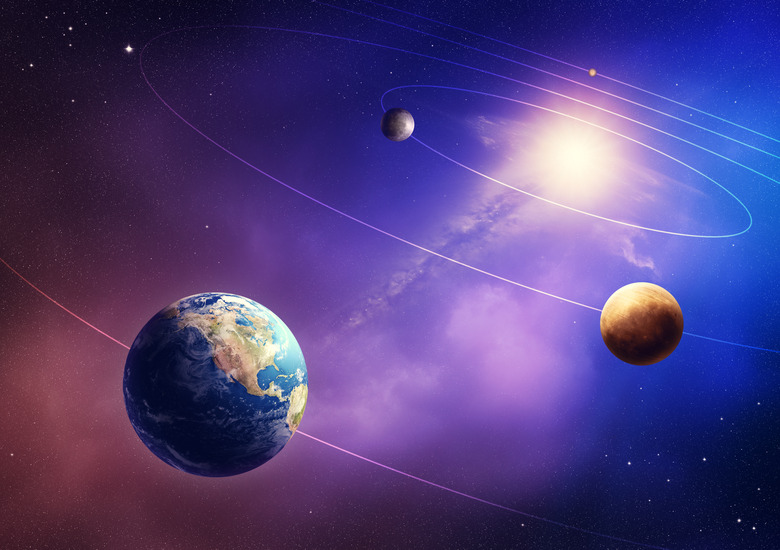What Does Ionization Energy Measure?
Ionization energy is an important concept in both chemistry and physics, but it is challenging to understand. The meaning touches on some of the details of the structure of atoms and in particular how strongly electrons are bound to the central nucleus in different elements. In short, ionization energy measures how much energy is required to remove an electron from the atom and turn it into an ion, which is an atom with a net charge.
TL;DR (Too Long; Didn't Read)
Ionization energy measures the amount of energy required to remove an electron from its orbit around an atom. The energy needed to remove the most weakly bound electron is the first ionization energy. The energy needed to remove the next most weakly bound electron is the second ionization energy and so on.
In general, ionization energy increases as you move across the periodic table from left to right or from bottom to top. However, specific energies may differ, so you should look up the ionization energy for any specific element.
What Is Ionization Energy?
What Is Ionization Energy?
Electrons occupy specific "orbitals" around the central nucleus in any atom. You can think about these as orbits in a way similar to how planets orbit the sun. In an atom, the negatively charged electrons are attracted to the positively charged protons. This attraction keeps the atom together.
Something has to overcome the attraction energy to remove an electron from its orbital. The ionization energy is the term for the amount of energy it takes to completely remove the electron from the atom and its attraction to the protons in the nucleus. Technically, there are many different ionization energies for elements heavier than hydrogen. The energy required to remove the most weakly attracted electron is the first ionization energy. The energy required to remove the next most weakly attracted electron is the second ionization energy and so on.
Ionization energies are either measured in kJ/mol (kilojoules per mole) or eV (electron-volts), with the former preferred in chemistry, and the latter preferred when dealing with single atoms in physics.
Factors Affecting Ionization Energy
Factors Affecting Ionization Energy
The ionization energy depends on a couple of different factors. In general, when there are more protons in the nucleus, the ionization energy increases. This makes sense because with more protons attracting the electrons, the energy required to overcome the attraction gets bigger. The other factor is whether the shell with the outermost electrons is fully occupied with electrons. A full shell – for example, the shell that contains both electrons in helium – is harder to remove electrons from than a partially filled shell because the layout is more stable. If there is a full shell with one electron in an outer shell, the electrons in the full shell "shield" the electron in the outer shell from some of the attractive force from the nucleus, and so the electron in the outer shell takes less energy to remove.
Ionization Energy and the Periodic Table
Ionization Energy and the Periodic Table
The periodic table arranges the elements by increasing atomic number, and its structure has a close link with the shells and orbitals electrons occupy. This provides an easy way to predict which elements have higher ionization energies than other elements. In general, ionization energy increases as you move from left to right across the periodic table because the number of protons in the nucleus increases. Ionization energy also increases when you move from the bottom to the top row of the table, because the elements on the lower rows have more electrons shielding the outer electrons from the central charge in the nucleus. There are some departures from this rule, though, so the best way to find the ionization energy of an atom is to look it up in a table.
The End Products of Ionization: Ions
The End Products of Ionization: Ions
An ion is an atom that has a net charge because the balance between the number of protons and electrons has been broken. When an element is ionized, the number of electrons decreases, so it is left with an excess of protons and a net positive charge. Positively charged ions are called cations. Table salt (sodium chloride) is an ionic compound that includes the cation version of the sodium atom, which has had an electron removed by a process that imparts the ionization energy. Although they aren't created by the same type of ionization because they gain an extra electron, negatively charged ions are called anions.
Cite This Article
MLA
Johnson, Lee. "What Does Ionization Energy Measure?" sciencing.com, https://www.sciencing.com/what-does-ionization-energy-measure-13710554/. 19 March 2018.
APA
Johnson, Lee. (2018, March 19). What Does Ionization Energy Measure?. sciencing.com. Retrieved from https://www.sciencing.com/what-does-ionization-energy-measure-13710554/
Chicago
Johnson, Lee. What Does Ionization Energy Measure? last modified March 24, 2022. https://www.sciencing.com/what-does-ionization-energy-measure-13710554/
